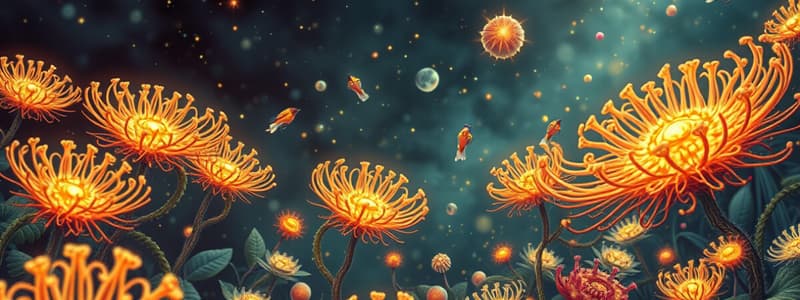Podcast
Questions and Answers
What are the general characteristics of organisms in Kingdom Protista?
What are the general characteristics of organisms in Kingdom Protista?
- Autotrophic or Heterotrophic (correct)
- Eukaryotic (correct)
- Most live on land
- Mainly Multicellular
Which of the following are the sub-divisions of Kingdom Protista?
Which of the following are the sub-divisions of Kingdom Protista?
- Fungi-like (correct)
- Animal-like (correct)
- Plant-like (correct)
- Bacterial-like
What is the nickname for animal-like protists?
What is the nickname for animal-like protists?
Protozoa
What type of protozoa uses cilia to move?
What type of protozoa uses cilia to move?
What are sporozoans known for?
What are sporozoans known for?
What is the function of pseudopodia?
What is the function of pseudopodia?
What do zooflagellates use to move?
What do zooflagellates use to move?
What are cilia?
What are cilia?
What is a sporozoite?
What is a sporozoite?
What caused the Irish Potato Famine?
What caused the Irish Potato Famine?
Which of the following are characteristics of euglenoids?
Which of the following are characteristics of euglenoids?
What is a common example of a ciliate?
What is a common example of a ciliate?
What is Giardia?
What is Giardia?
What is a diatom?
What is a diatom?
What type of algae can be toxic and luminescent?
What type of algae can be toxic and luminescent?
Flashcards are hidden until you start studying
Study Notes
Kingdom Protista Overview
- Eukaryotic organisms that can be autotrophic or heterotrophic
- Mainly unicellular, predominantly found in aquatic environments
Sub-divisions of Protists
- Divided into three groups:
- Animal-like protists (Protozoa)
- Plant-like protists
- Fungus-like protists
Protozoa
- Commonly referred to as "first animals"
Types of Protozoa
-
Ciliate:
- Moves using cilia
- Example: Paramecium
-
Sporozoan:
- Parasitic and non-motile, lives in/on hosts
- Reproduces via sporozite, akin to fungal spores
- Example: Plasmodium (causes Malaria)
-
Sarcodine:
- Moves using temporary extensions of its cell membrane called pseudopodia
- Example: Amoeba
-
Zooflagellate:
- Moves with whip-like tail known as flagella
Key Structures
-
Cilia:
- Hair-like projections that aid in movement and feeding
-
Pseudopod:
- Temporary bulge used for movement and feeding in Sarcodines
-
Sporozite:
- Form used by Sporozoans for reproduction
-
Flagella:
- Tail structure enabling movement in Zooflagellates
Fungus-like Protists
- Function as decomposers
- Includes slime molds, water molds, and downy mildew
Notable Fungus-like Protists
- Water mold:
- Infamous for causing the Irish Potato Famine
Plant-like Protists
-
Euglenoids:
- Green, unicellular protists, primarily autotrophic but can switch to heterotrophic
-
Euglena:
- Possesses chloroplasts, contractile vacuole, flagella, and eyespot; capable of both autotrophy and heterotrophy
-
Algae:
- Includes green, red, and brown types, mostly multicellular and aquatic
- Examples: Seaweed, kelp, dinoflagellates, diatoms
Notable Examples
-
Diatom:
- Unicellular algae with glass-like cell walls, harvested for use in insecticides
-
Dinoflagellate:
- Unicellular, can be toxic, and exhibit luminescence
-
Giardia:
- Zooflagellate responsible for hiker’s illness
-
Paramecium:
- Common ciliate, recognized by its shoe-like shape and oral groove
Summary of Key Organisms
- Plasmodium:
- Parasitic sporozoan causing malaria
- Amoeba:
- A well-known example of sarcodine protists
Studying That Suits You
Use AI to generate personalized quizzes and flashcards to suit your learning preferences.




